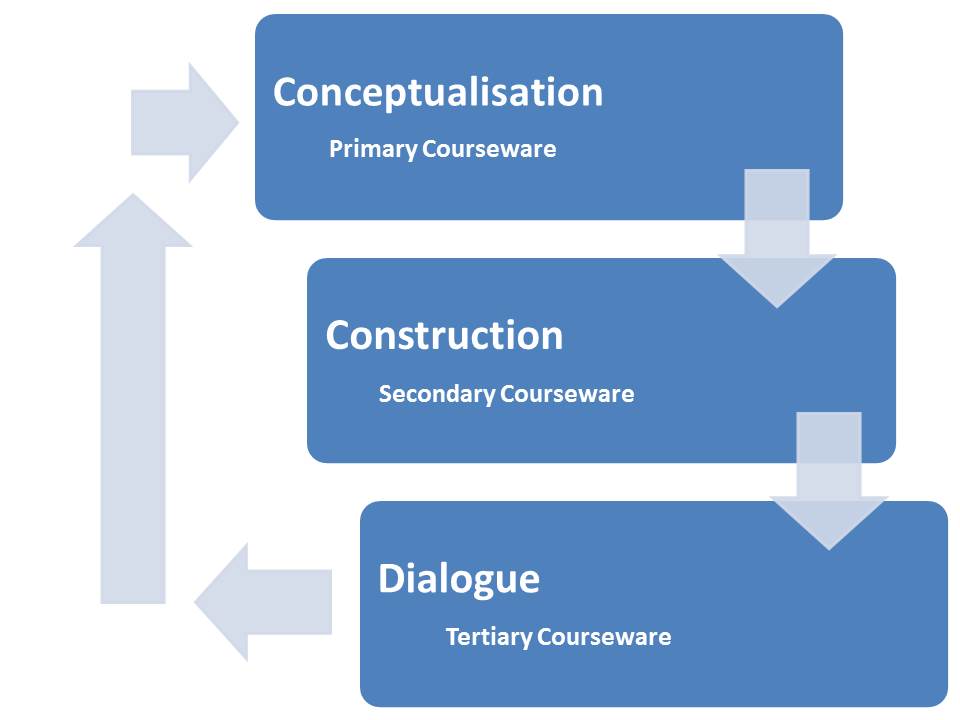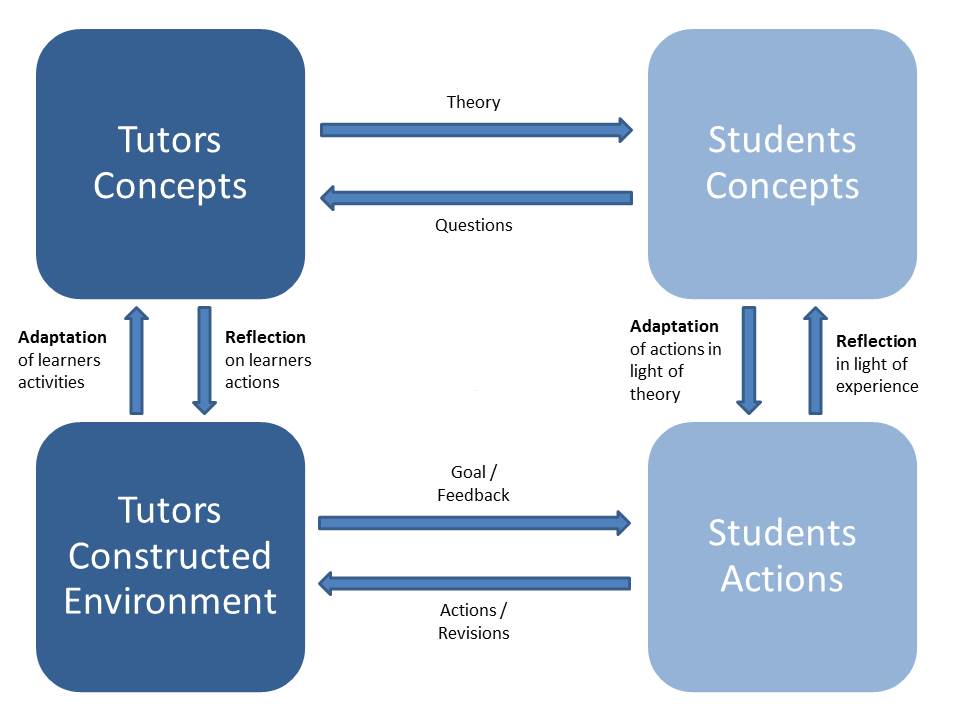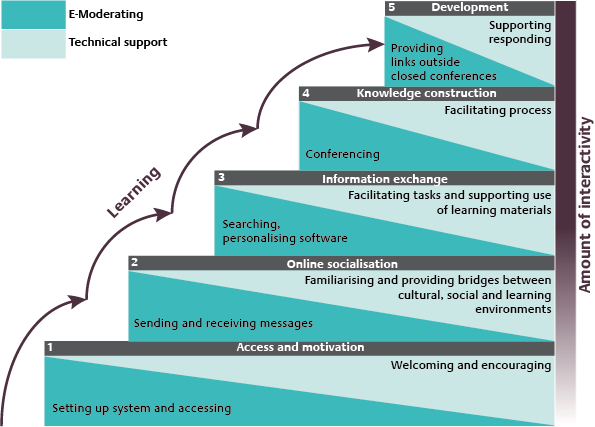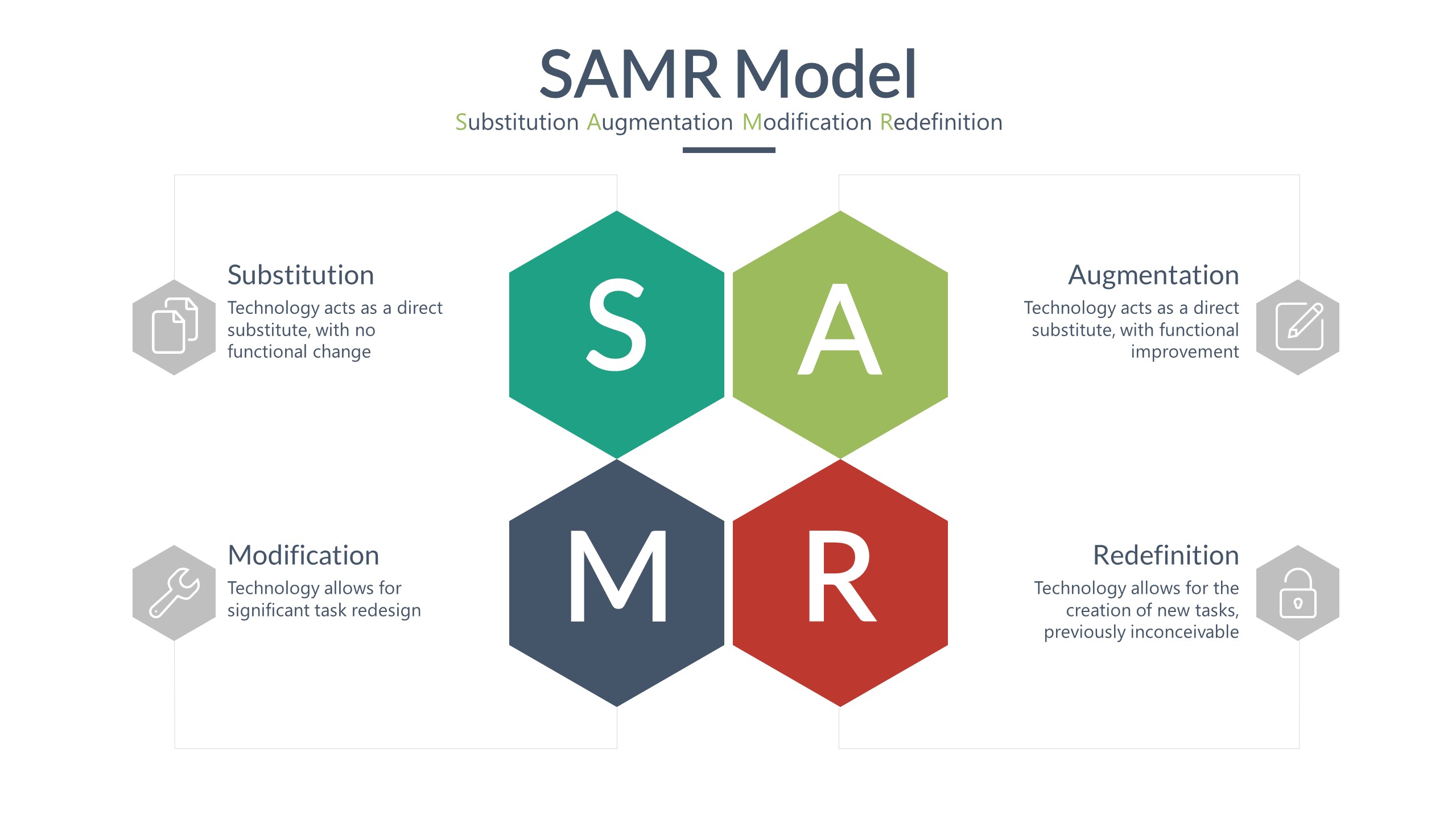ePedagogy
Combining traditional learning theories, such as constructivism, cognitivism and behaviourism, with contemporary theories such as connectivism, gives us the foundation on which to develop successful models for online and blended learning.
Based on these theories, other models have been developed to underpin TEL pedagogy; on this page we’ll take a look at just three of them: Mayes and Fowler’s (1999) Conceptualisation Cycle, Laurillard’s (2002) Conversational Framework, and Salmon’s (2011) Five Stage Model.
Mayes’ Conceptualisation Cycle
At the conceptualisation stage, students are exposed to other people’s ideas or concepts. The purpose of this stage is to provide the learner with an awareness of what they need to learn and understand, this is most commonly achieved in face to face classroom or lecture based sessions but also takes place in the VLE. Primary Courseware is used to support, for example, online lecture notes, instructional videos, reading lists etc., which are a good way of giving students information.
At the construction stage tutors provide learners with meaningful online tasks that allow them to apply the concepts outlined to them in the conceptualisation stage, such as lab work, preparing presentations, writing blog posts, online quizzes, etc. The learning environment, tasks and task materials are referred to as Secondary Courseware.
However, it is only at the dialogue stage, in the performance of tasks in which these new concepts are tested during conversation with tutors and peers, that learning takes place. This is achieved by students participating in effective computer mediated communication (CMC) with their tutors and fellow students whereby their understanding and conceptualisations outlined in stage 1 and applied in stage 2 can be assessed in applied contexts via online discourse which will bring to light any misconceptions about the subject and allow these to be addressed via meaningful online two way conversations. This is engagement with Tertiary Courseware e.g. discussion forums, videoconferencing, simulations etc.
Each (larger) pedagogical scenario should include all four kinds of activities (communication forms) that happened in eight kinds of ‘flows’ in the model.
Laurillard’s Conversational Framework
Laurillard’s Conversational Framework (Laurillard, 2002) has been widely cited and used as both a design template and an analytic tool. Laurillard describes the stages involved in the dialogic interaction between a tutor and student, demonstrating the way in which concepts are internalised and adapted by each in the process. Laurillard stresses that, for higher level learning, dialogue must take place at both a theoretical and practical level.
Laurillard (2002) claims that there are four main aspects of the teaching-learning process and that different educational media can be analysed (and used) in terms of these dimensions:
- Tutors’ Concepts
- Tutors’ Constructed Learning Environment
- Students’ Concepts
- Students’ Specific Actions
Tutors and learners’ conception should be mutually accessible Both should agree on learning objectives
Tutor must adapt objectives with regards to existing conceptions Learners must integrate feedback and link it to his own conception
Tutor must create an environment adapted to the learning task given to the learner Tutor must focus on support for task and give appropriate feedback to the learner
Tutor should support the learner to revise his conceptions and to adapt the task to learning needs Learners should reflect with all stages of the learning process (initial concepts, tasks, objectives, feedback, …)
Salmon’s Five Stage Model
Professor Gilly Salmon first developed the practical Five Stage Model, ‘scaffolding’ a progressive learning environment through online activities, or ‘e-tivities’, as part of her own research into online learning and the use of computer-mediated communication (CMC), and published it in her book E-moderating (Salmon, 2011). The five stages are:
At stage one, e-moderators need to provide support and allow sufficient time to enable learners to access their course materials. Maintaining motivation in the early stages is important because you do not want to deter your learners before they have properly started the course. At this early stage, there will be little interaction between learners.
Now that your learners have all successfully ‘arrived’, stage-two focuses upon encouraging your learners to get to know each other; even if you are teaching students online as part of a blended learning approach, and everyone has already met each other in the lecture theatre or seminar room, it is still important to go through this process in the online environment too.
On the successful completion of stage-two, your learners can be encouraged to share information as they continue to connect and build upon the relationships they started to develop with each other earlier. Exchanging information can be fun and beneficial but it can also be overwhelming if too much is shared and learners cannot identify what is useful to them.
At stage-four, learners should now be ready for more active online learning and can begin to construct new knowledge as a result of their interaction with one another, drawing upon each other’s skills and experience.
At stage-five, learners become more independent from the e-moderator and take more responsibility for their own learning and their group. Learner interaction with peers is not necessarily as frequent and demanding as seen in stages two to four, as learners can become more focused upon their individual learning goals again.
The amount of interactivity between an individual learner and their colleagues increases with each step. Importantly, as the expectations of participants increase, the role of the e-moderator shifts to a more facilitative role.
The Substitution Augmentation Modification Redefinition Model (SAMR) offers a method of seeing how technology might impact teaching and learning. It also shows a progression that adopters of educational technology often follow as they progress through teaching and learning with technology.
SAMR Model
SAMR is a model designed to help educators infuse technology into teaching and learning. SAMR is an acronym that stands for Substitution, Augmentation, Modification, and Redefinition, and the model supports and enables academics to design, develop, and infuse digital learning experiences that utilise technology.
Substitution and Augmentation are considered "Enhancement" steps, while Modification and Redefinition are termed "Transformation" steps.
At this stage, technology is directly substituted for a more traditional one, a simple direct replacement.
The technology is again directly substituted for a traditional one, but with significant enhancements to the student experience. In other words, you ask yourself if the technology increases or augments a student's productivity and potential in some way.
In this stage, you are beginning to move from enhancement to transformation on the model. Instead of replacement or enhancement, this is an actual change to the design of the session and its learning outcome. The key question here is 'does the technology significantly alter the task'?
The last stage of the SAMR model is Redefinition and represents the pinnacle of how technology can transform a student’s experience. In this case, you ask yourself if the technology tools allow educators to redefine a traditional task in a way that would not be possible without the tech, creating a novel experience.
Summary
As Conole (2010) suggests, models or frameworks, such as these, can be used as a type of schema to help mentally align to a particular pedagogical approach. Alternatively, they can be used directly to help guide the design of a learning activity or course, to help guide design decisions about what kinds of learning activities would be appropriate to promote the pedagogical approach instantiated in the model or framework. They can be used to guide the development of a learning environment, or they can be used as direct representations to the students, to help guide their learning process, or as analytic or descriptive tools to describe practice.
Conole, G. 2010. Review of pedagogical models and frameworks. [Online, licensed under CC BY-NC-SA 2.0]. Accessed 8 October 2015. Available from http://cloudworks.ac.uk/cloud/view/2982
Laurillard, D. 2002. Rethinking University Teaching. A conversational framework for the effective use of learning technologies. London: Routledge
Mayes, J.T. & Fowler, C.J.H. 1999. Learning technology and usability: a framework for understanding courseware. Interacting with Computers. 11, pp. 485-497
Salmon, G. 2013. E-tivities: The Key to Active Online Learning. 2nd ed. New York: Routledge
Salmon, G. 2011. E-moderating: The key to teaching and learning online. 3rd ed. New York: Routledge




